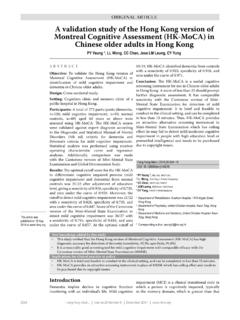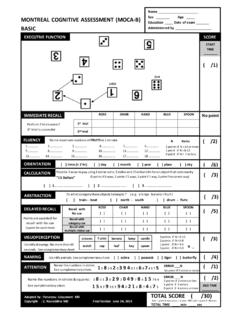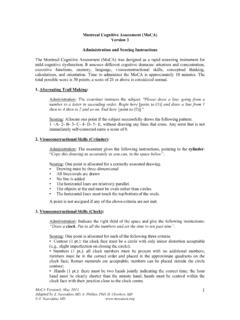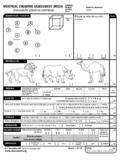Transcription of Montreal Cognitive Assessment - University of …
1 moca Version2; May 2011 Adapted by: Z. Nasreddine MD, N. Phillips, PhD, H. Chertkow, MD Z. Nasreddine MD 1 Montreal Cognitive Assessment ( moca ) Version 2 Administration and Scoring Instructions The Montreal Cognitive Assessment ( moca ) was designed as a rapid screening instrument for mild Cognitive dysfunction. It assesses different Cognitive domains: attention and concentration, executive functions, memory, language, visuoconstructional skills, conceptual thinking, calculations, and orientation. Time to administer the moca is approximately 10 minutes. The total possible score is 30 points; a score of 26 or above is considered normal. 1. Alternating Trail Making: Administration: The examiner instructs the subject: "Please draw a line, going from a number to a letter in ascending order.
2 Begin here [point to (1)] and draw a line from 1 then to A then to 2 and so on. End here [point to (E)]." Scoring: Allocate one point if the subject successfully draws the following pattern: 1 A- 2- B- 3- C- 4- D- 5- E, without drawing any lines that cross. Any error that is not immediately self-corrected earns a score of 0. 2. Visuoconstructional Skills (Rectangle): Administration: The examiner gives the following instructions, pointing to the rectangle: Copy this drawing as accurately as you can, in the space below . Scoring: One point is allocated for a correctly executed drawing. Drawing must be three-dimensional All lines are drawn No line is added The horizontal lines are relatively parallel.
3 The object must be clearly rectangular ( , the shorter vertical sides cannot be more than of the length of the longer horizontal lines. A point is not assigned if any of the above-criteria are not met. 3. Visuoconstructional Skills (Clock): Administration: Indicate the right third of the space and give the following instructions: Draw a clock. Put in all the numbers and set the time to 5 past 4 . Scoring: One point is allocated for each of the following three criteria: Contour (1 pt.): the clock face must be a circle with only minor distortion acceptable ( , slight imperfection on closing the circle); Numbers (1 pt.): all clock numbers must be present with no additional numbers; numbers must be in the correct order and placed in the approximate quadrants on the clock face; Roman numerals are acceptable; numbers can be placed outside the circle contour; Hands (1 pt.))
4 : there must be two hands jointly indicating the correct time; the hour hand must be clearly shorter than the minute hand; hands must be centred within the clock face with their junction close to the clock centre. A point is not assigned for a given element if any of the above-criteria are not met. moca Version2; May 2011 Adapted by: Z. Nasreddine MD, N. Phillips, PhD, H. Chertkow, MD Z. Nasreddine MD 2 4. Naming: Administration: Beginning on the left, point to each figure and say: Tell me the name of this animal . Scoring: One point each is given for the following responses: (1) giraffe; (2) bear (or specific varieties of bears); (3) hippopotamus (or hippo). 5. Memory: Administration: The examiner reads a list of 5 words at a rate of one per second, giving the following instructions: This is a memory test.
5 I am going to read a list of words that you will have to remember now and later on. Listen carefully. When I am through, tell me as many words as you can remember. It doesn t matter in what order you say them. Mark a check in the allocated space for each word the subject produces on this first trial. When the subject indicates that (s)he has finished (has recalled all words), or can recall no more words, read the list a second time with the following instructions: I am going to read the same list for a second time. Try to remember and tell me as many words as you can, including words you said the first time. Put a check in the allocated space for each word the subject recalls after the second trial.
6 At the end of the second trial, inform the subject that (s)he will be asked to recall these words again by saying, I will ask you to recall those words again at the end of the test. Scoring: No points are given for Trials One and Two. Scoring is based on the delayed recall trial. 6. Attention: Forward Digit Span: Administration: Give the following instruction: I am going to say some numbers and when I am through, repeat them to me exactly as I said them . Read the five number sequence at a rate of one digit per second. Backward Digit Span: Administration: Give the following instruction: Now I am going to say some more numbers, but when I am through you must repeat them to me in the backwards order.
7 Read the three number sequence at a rate of one digit per second. Scoring: Allocate one point for each sequence correctly repeated, ( : the correct response for the backwards trial is 2-5-8). Vigilance: Administration: The examiner reads the list of letters at a rate of one per second, after giving the following instruction: I am going to read a sequence of letters. Every time I say the letter A, tap your hand once. If I say a different letter, do not tap your hand . Scoring: Give one point if there is zero to one errors (an error is a tap on a wrong letter or a failure to tap on letter A). moca Version2; May 2011 Adapted by: Z. Nasreddine MD, N. Phillips, PhD, H. Chertkow, MD Z. Nasreddine MD 3 Serial 7s: Administration: The examiner gives the following instruction: Now, I will ask you to count by subtracting 7 from 90, and then, keep subtracting 7 from your answer until I tell you to stop.
8 Give this instruction twice if necessary. Scoring: This item is scored out of 3 points. Give no (0) points for no correct subtractions, 1 point for one correction subtraction, 2 points for two-to-three correct subtractions, and 3 points if the participant successfully makes four or five correct subtractions. Count each correct subtraction of 7 beginning at 100. Each subtraction is evaluated independently; that is, if the participant responds with an incorrect number but continues to correctly subtract 7 from it, give a point for each correct subtraction. For example, a participant may respond 82 75 68 61 54 where the 82 is incorrect, but all subsequent numbers are subtracted correctly. This is one error and the item would be given a score of 3.
9 7. Sentence repetition: Administration: The examiner gives the following instructions: I am going to read you a sentence. Repeat it after me, exactly as I say it [pause]: A bird can fly into closed windows when it s dark and windy. Following the response, say: Now I am going to read you another sentence. Repeat it after me, exactly as I say it [pause]: The caring grandmother sent groceries over a week ago. Scoring: Allocate 1 point for each sentence correctly repeated. Repetition must be exact. Be alert for errors that are omissions ( , omitting "closed", "over") and substitutions/additions ( , "Birds can easily fly into closed windows .. ; substituting "stormy" for "windy", altering plurals, etc.)
10 8. Verbal fluency: Administration: The examiner gives the following instruction: Tell me as many words as you can think of that begin with a certain letter of the alphabet that I will tell you in a moment. You can say any kind of word you want, except for proper nouns (like Bob or Boston), numbers, or words that begin with the same sound but have a different suffix, for example, love, lover, loving. I will tell you to stop after one minute. Are you ready? [Pause] Now, tell me as many words as you can think of that begin with the letter S. [time for 60 sec]. Stop. Scoring: Allocate one point if the subject generates 11 words or more in 60 sec. Record the subject s response in the bottom or side margins.









